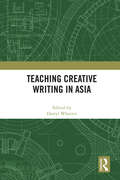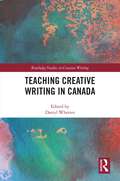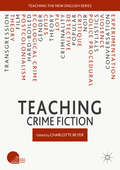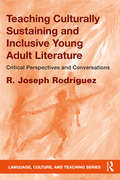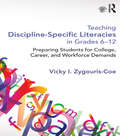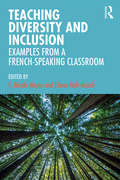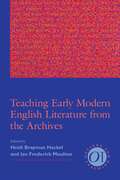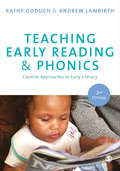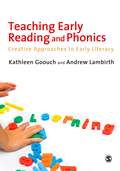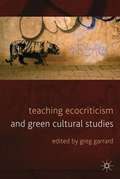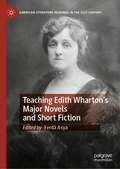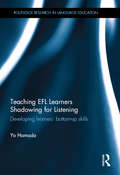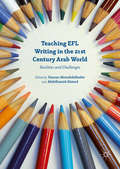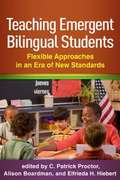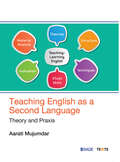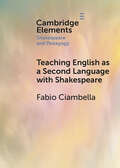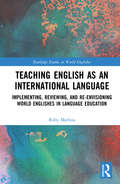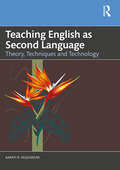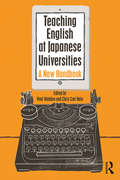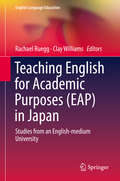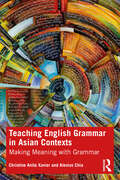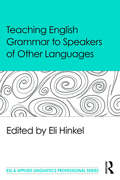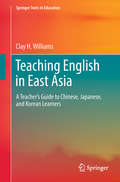- Table View
- List View
Teaching Creative Writing in Asia
by Darryl WhetterThis book examines the dynamic landscape of creative educations in Asia, exploring the intersection of post-coloniality, translation, and creative educations in one of the world’s most relevant testing grounds for STEM versus STEAM educational debates. Several essays attend to one of today’s most pressing issues in Creative Writing education, and education generally: the convergence of the former educational revolution of Creative Writing in the anglophone world with a defining aspect of the 21st-century—the shift from monolingual to multilingual writers and learners. The essays look at examples from across Asia with specific experience from India, Singapore, China, Hong Kong, the Philippines and Taiwan. Each of the 14 writer-professor contributors has taught Creative Writing substantially in Asia, often creating and directing the first university Creative Writing programs there. This book will be of interest to anyone following global trends within creative writing and those with an interest in education and multilingualism in Asia.
Teaching Creative Writing in Canada (Routledge Studies in Creative Writing)
by Darryl WhetterTeaching Creative Writing in Canada maps the landscape of Creative Writing programmes across Canada. Canada’s position, both culturally and physically, as a midpoint between the two major Anglophone influences on Creative Writing pedagogyy—the UK and the USA—makes it a unique and relevant vantage for the study of contemporary Creative Writing pedagogy.Showcasing writer-professors from Canada’s major Creative Writing programmes, the collection considers the climate-crisis, contemporary workshop scepticism, curriculum design, programme management, prize culture, grants and interdisciplinarity. Each chapter concludes with field-tested writing advice from many of Canada’s most influential professors of fiction, poetry, creative nonfiction and drama.This authoritative volume offers an important national perspective on contemporary and timeless issues in Creative Writing pedagogy and their varied treatment in Canada. It will be of valuable to other creative teachers and practitioners, those with an interest in teaching and learning a creative art and anyone working on cultural and educational landscapes.
Teaching Crime Fiction (Teaching the New English)
by Charlotte BeyerMore than perhaps any other genre, crime fiction invites debate over the role of popular fiction in English studies. This book offers lively original essays on teaching crime fiction written by experienced British and international scholar teachers, providing vital insight into this diverse genre through a series of compelling subjects. Taking its starting-point in pedagogical reflections and classroom experiences, the book explores methods for teaching students to develop their own critical perspectives as crime fiction critics, the impact of feminism, postcolonialism, and ecocriticism on crime fiction, crime fiction and film, the crime short story, postgraduate perspectives, and more.
Teaching Culturally Sustaining and Inclusive Young Adult Literature: Critical Perspectives and Conversations (Language, Culture, and Teaching Series)
by R. Joseph RodríguezIn this book, Rodríguez uses theories of critical literacy and culturally responsive teaching to argue that our schools, and our culture, need sustaining and inclusive young adult (YA) literature/s to meet the needs of culturally and linguistically diverse readers and all students. This book provides an outline for the study of literature through cultural and literary criticism, via essays that analyze selected YA literature (drama, fiction, nonfiction, and poetry) in four areas: scribal identities and the self-affirmation of adolescents; gender and sexualities; schooling and education of young adult characters; and teachers’ roles and influences in characters’ coming of age. Applying critical literacy theories and a youth studies lens, this book shines a light on the need for culturally sustaining and inclusive pedagogies to read adolescent worlds. Complementing these essays are critical conversations with seven key contemporary YA literature writers, adding biographical perspectives to further expand the critical scholarship and merits of YA literature.
Teaching Discipline-Specific Literacies in Grades 6-12: Preparing Students for College, Career, and Workforce Demands
by Vicky I. Zygouris-CoeComprehensive, timely, and relevant, this text offers an approach to discipline-specific literacy instruction that is aligned with the Common Core State Standards and the needs of teachers, students, and secondary schools across the nation. It is essential that teachers know how to provide instruction that both develops content and literacy knowledge and skills, and aims at reducing student achievement gaps. Building on the research-supported premise that discipline-specific reading instruction is key to achieving these goals, this text provides practical guidance and strategies for prospective and practicing content area teachers (and other educators) on how to prepare all students to succeed in college and the workforce. Pedagogical features in each chapter engage readers in digging deeper and in applying the ideas and strategies presented in their own contexts: Classroom Life (real 6-12 classroom scenarios and interviews with content-area teachers) Common Core State Standards Connections College, Career, and Workforce Connections Applying Discipline-Specific Literacies Think Like an Expert ("habits of thinking and learning" specific to each discipline) Digital Literacies Differentiating Instruction Reflect and Apply Questions Extending Learning Activities The Companion Website includes: Lesson plan resources Annotated links to video files Annotated links to additional resources and information Glossary/Flashcards For Instructors: All images and figures used in the text provided in an easily downloadable format For Instructors: PowerPoint lecture slides
Teaching Diversity and Inclusion: Examples from a French-Speaking Classroom
by E. Nicole MeyerTeaching Diversity and Inclusion: Examples from a French-Speaking Classroom explores new and pioneering strategies for transforming current teaching practices into equitable, inclusive and immersive classrooms for all students. This cutting-edge volume dares to ask new questions, and shares innovative, concrete tools useful to a wide variety of classrooms and institutional contexts, far beyond any disciplinary borders. This book aims to instill classroom approaches which allow every student to feel safe to share their truth and to reflect deeply about their own identity and challenges, discussing course design, assignments, technologies, activities, and strategies that target diversity and inclusion in the French classroom. Each chapter shares why and how to design an inclusive community of learners, including opportunities to promote interdisciplinary approaches and cross-disciplinary collaborations, exploring cultures and underrepresented perspectives, and distinguishing unconscious biases. The essays also provide theoretical and practical strategies adaptable to any reflective teacher desiring to create a welcoming, inclusive classroom that draws in students they might not otherwise attract. This long overdue work will be ideal for both undergraduate and graduate students and administrators seeking fresh approaches to diversity in the classroom.
Teaching Early Modern English Literature from the Archives (Options for Teaching #36)
by Heidi Brayman Hackel and Ian Frederick MoultonThe availability of digital editions of early modern works brings a wealth of exciting archival and primary source materials into the classroom. But electronic archives can be overwhelming and hard to use, for teachers and students alike, and digitization can distort or omit information about texts. Teaching Early Modern English Literature from the Archives places traditional and electronic archives in conversation, outlines practical methods for incorporating them into the undergraduate and graduate curriculum, and addresses the theoretical issues involved in studying them. The volume discusses a range of physical and virtual archives from 1473 to 1700 that are useful in the teaching of early modern literature--both major sources and rich collections that are less known (including affordable or free options for those with limited institutional resources).Although the volume focuses on English literature and culture, essays discuss a wide range of comparative approaches involving Latin, French, Spanish, German, and early American texts and explain how to incorporate visual materials, ballads, domestic treatises, atlases, music, and historical documents into the teaching of literature.
Teaching Early Reading and Phonics: Creative Approaches to Early Literacy
by Kathy Goouch Andrew LambirthLearning to read is an exciting and vital part of every child’s development. The new edition of this book continues to provide trainees and teachers with a broad understanding of teaching reading and phonics, and equip them with the skills necessary to face the reality of the early years classroom in order to meet the needs of individual children. With vital information on constructing relationships with young readers, and how to plan phonics within a rich, interactive and playful literacy pedagogy, the second edition now includes: A brand new chapter on babies and early reading More information on language acquisition and how children learn A discussion of children with SEN An appreciation for the rise of digital technologies in relation to reading Whether you're training to become a teacher, or already working in the classroom this book is ideal for those who wish to embed the teaching of phonics into carefully selected high quality materials - particularly in children's literature.
Teaching Early Reading and Phonics: Creative Approaches to Early Literacy
by Kathy Goouch Andrew LambirthLearning to read is an exciting and vital part of every child's development. The new edition of this book continues to provide trainees and teachers with a broad understanding of teaching reading & phonics, and equip them with the skills necessary to face the reality of the early years classroom in order to meet the needs of individual children. With vital information on constructing relationships with the young readers, and how to plan phonics within a rich, interactive and playful literacy pedagogy, the second edition now includes; - A brand new chapter on babies and early reading - More information on language acquisition and how children learn - A discussion of children with SEN - An appreciation for the rise of digital technologies in relation to reading Whether you're training to become a teacher, or already working in the classroom this book is ideal for those who wish embed the teaching of phonics into carefully selected high quality materials - particularly in children's literature.
Teaching Early Reading and Phonics
by Kathy Goouch Andrew LambirthTeaching Early Reading and Phonics: Creative Approaches to Early Literacy supports teachers using phonics in their teaching of early reading. The authors show how important it is to ensure that children acquire a wide range of reading strategies, while also setting out practical ’pointers’ which will enable teachers to translate the theory into effective practice. Readers will learn how to plan phonics within a rich, interactive and playful literacy pedagogy; how to construct relationships with the young readers in their classes and the texts around them; how to embed the teaching of phonics in carefully selected high quality materials – particularly in children’s literature. Written for practicing teachers, student teachers on initial teacher training courses at undergraduate and graduate levels, the book will also be useful for advisors working on continuing professional development.
Teaching Ecocriticism and Green Cultural Studies
by Greg GarrardEcocriticism is one of the most vibrant fields of cultural study today, and environmental issues are controversial and topical. This volume captures the excitement of green reading, reflects on its relationship to the modern academy, and provides practical guidance for dealing with global scale, interdisciplinarity, apathy and scepticism.
Teaching Edith Wharton’s Major Novels and Short Fiction (American Literature Readings in the 21st Century)
by Ferdâ AsyaThis book translates recent scholarship into pedagogy for teaching Edith Wharton’s widely celebrated and less-known fiction to students in the twenty-first century. It comprises such themes as American and European cultures, material culture, identity, sexuality, class, gender, law, history, journalism, anarchism, war, addiction, disability, ecology, technology, and social media in historical, cultural, transcultural, international, and regional contexts. It includes Wharton’s works compared to those of other authors, taught online, read in foreign universities, and studied in film adaptations.
Teaching EFL Learners Shadowing for Listening: Developing learners' bottom-up skills (Routledge Research in Language Education)
by Yo HamadaShadowing, an active and highly cognitive technique for EFL listening skill development, in which learners track heard speech and vocalize it simultaneously, is gradually becoming recognized. However, there remain a lot of mysteries and misunderstandings about it. This book uncovers shadowing in terms of theory and practice. This book cements shadowing as a separate technique from other similar techniques such as Elicited Imitation, Mirroring, and simple repetition, and provides ample empirical data to explain the function of Shadowing. It also elaborates on how Shadowing should be used in terms of materials, procedure, and learners’ psychology, which would aid in instructors’ use of Shadowing in teaching. A guide on a method effective in improving learners’ bottom-up listening skills, this book will certainly prove useful to English Language learners and instructors in their linguistic pursuits.
Teaching EFL Writing in the 21st Century Arab World
by Abdelhamid Ahmed Hassan AbouabdelkaderTeaching EFL Writing in the 21st Century Arab World addresses a range of issues related to researching and teaching EFL writing in different countries in the Arab World including Egypt, Morocco, Oman, Palestine, Tunisia, UAE and Yemen. Both theoretically and practically grounded, chapters within discuss the different contexts in which EFL writing is taught, from primary school to university. The book sheds light on how EFL writing is learned and taught at each educational stage, exposing the different challenges encountered in the teaching and learning. The focus on EFL writing in the Arab World makes this a unique and long overdue contribution to the field of research around EFL writing and will be an invaluable resource for researchers, curriculum designers and students.
Teaching Emergent Bilingual Students: Flexible Approaches in an Era of New Standards
by C. Patrick Proctor Elfrieda H. Hiebert Alison BoardmanRecent educational reform initiatives such as the Common Core State Standards (CCSS) largely fail to address the needs--or tap into the unique resources--of students who are developing literacy skills in both English and a home language. This book discusses ways to meet the challenges that current standards pose for teaching emergent bilingual students in grades K-8. Leading experts describe effective, standards-aligned instructional approaches and programs expressly developed to promote bilingual learners' academic vocabulary, comprehension, speaking, writing, and content learning. Innovative policy recommendations and professional development approaches are also presented.
Teaching English as a Second Language: Theory and Praxis
by Aarati MujumdarA systematic and well-researched textbook with a multidisciplinary approach to understand the methods and techniques of teaching English as a second language. This book provides an easy-to-understand and easy-to-apply discussion on language structure, pronunciation, intonation, grammar, and vocabulary through numerous tasks and exercises. The section on "instructional practices" deals with various language skills and their applications in real-world classrooms. With actual classroom-tested techniques, Teaching English as a Second Language: Theory and Praxis would be an ideal companion for BEd students who are in the process of becoming teachers. It would also help practicing teachers who can modify and adapt these techniques and tasks to aid students develop language skills required to face the challenges of the twenty-first century. Key Features • Provides a comprehensive introduction to second language teaching with reference to the recent trends and developments in the area • Enables teachers to adopt a problem-solving approach to teaching English • Uses communicative language teaching (CLT) and task-based teaching methodology, helping learners to develop communication of meaning along with accuracy of form • Dedicated sections on classroom evaluation techniques and use of audiovisual aids and other resources for language teaching
Teaching English as a Second Language with Shakespeare (Elements in Shakespeare and Pedagogy)
by Fabio CiambellaTeaching pragmatics, that is, language in use, is one of the most difficult and consequently neglected tasks in many English as a Second Language classrooms. This Element aims to address a gap in the scholarly debate about Shakespeare and pedagogy, combining pragmatic considerations about how to approach Shakespeare's language today in ESL classes, and practical applications in the shape of ready-made lesson plans for both university and secondary school students. Its originality consists in both its structure and the methodology adopted. Three main sections cover different aspects of pragmatics: performative speech acts, discourse markers, and (im)politeness strategies. Each section is introduced by an overview of the topic and state of the art, then details are provided about how to approach Shakespeare's plays through a given pragmatic method. Finally, an example of an interactive, ready-made lesson plan is provided.
Teaching English as an International Language: Implementing, Reviewing, and Re-Envisioning World Englishes in Language Education (Routledge Studies in World Englishes)
by Roby MarlinaHow do teachers inspire students to learn to appreciate different Englishes? Has anyone tried to teach world Englishes? If so, what do they do and how do they feel about it? Most importantly, do students see the benefits in learning about world Englishes? This book responds to these questions by 1) offering a clear and solid foundation for the development of English as an International Language (EIL)-oriented curricula in an English Language program and a teacher education program, 2) critically reviewing the current pedagogical principles and practices of teaching EIL, and 3) offering an alternative way of conceptualising and teaching EIL. Using a three-year undergraduate program of EIL in an Australian university as a research site, this book provides a detailed account of actual classroom practices that raise students’ awareness of world Englishes and engage them in learning how to communicate interculturally. This book is the first of its kind that explores the teaching of EIL in a country where English is a predominant and national language.
Teaching English as Second Language: Theory, Techniques and Technology
by Aarati R MujumdarThis multidisciplinary volume is a systematic, well-researched resource to help understand the methods and techniques of teaching English as a second language. It integrates theory with praxis, drawing on the Cognitivist–Social interactionist theory and Constructivist approaches adopted in an English classroom. It provides insights into recent trends in teaching, given the changed teaching–learning scenario in education, while simultaneously aiding in the development of the 4IR skills much needed in the 21st century.Written in an easy-to-understand language, the book expounds on various language skills and their application in real-world classrooms. These classroom-tested techniques can be used by teachers by modifying the context in which they are used. The tasks help develop critical-thinking and problem-solving abilities in learners. The techniques and practices elucidated in the book are designed to be accessible to a global readership.This book will be useful to students, pre-service teachers, and researchers, who are new to the teaching of English Language. It will also be an essential companion to practicing in-service teachers and Teacher Trainers to further sharpen their concepts and skills.
Teaching English at Japanese Universities: A New Handbook
by Paul Wadden Chris Carl HaleWritten by leading English-language educators in Japan, this Handbook provides an in-depth guide for the new generation of teachers at Japanese universities. In clear, accessible prose, it offers practical and detailed advice on effective classroom pedagogy, student motivation, learning styles, classroom culture, national language policy, career opportunities, departmental politics, administrative mindset, and institutional identity. Its four sections—The setting, The courses, The classroom, and The workplace—examine issues faced by university language teachers as well as challenges confronted by the increasing number of scholars teaching English as a Medium of Instruction (EMI) and Content and Language Integrated Learning (CLIL) courses. Firmly grounded in contemporary teaching method and theory, the Handbook’s 23 chapters also acknowledge the influence of diverse movements such as World Englishes, global issues, gender, and positive psychology. Its three appendices contain information on organizations, books, journals, and websites particularly useful for Japanese university educators; explanation of types and rankings of schools; ways to learn more about individual institutions for job-hunting; and detailed information on the structure (and Japanese titles) of faculty and non-teaching staff at the typical university. This Handbook is an invaluable resource for anyone teaching, or aspiring to teach, at a Japanese university.
Teaching English for Academic Purposes: Theory into Practice
by Ece Zehir Topkaya Handan ÇelikThis book offers a helpful resource for English for Academic Purposes (EAP) practitioners, combining theoretical content with in-depth insights rooted in practice. EAP has a key role in preparing students for academic challenges in English-medium universities globally. With the increasing need for proficiency in academic English, there is a demand for a comprehensive resource that caters to instructors who are actively involved in or considering a career in the teaching of EAP. This book addresses this need through five clear thematic sections: the development of EAP practice and pedagogy, creating effective EAP courses, exploring linguistic issues, language skills, and EAP instruction, issues in assessment of learning and practice in EAP, and current perspectives in EAP. The volume features contributions from experts with extensive EAP teaching experience, research backgrounds, and scholarly publications. By drawing on their theoretical understanding and practical insights, the book will equip ELT professionals with essential knowledge, strategies, and practical approaches to tailor their instruction to the unique needs of EAP learners. It will also be of interest to teacher educators, students, and academics researching language teaching in English for Academic Purposes, English for Specific Purposes and English-Medium Instruction contexts.
Teaching English for Academic Purposes: Studies From An English-medium University (English Language Education #14)
by Rachael Ruegg Clay WilliamsThis book focuses on appropriate English for Academic Purposes instructional concepts and methods in the Japanese context. It investigates a variety of pedagogical techniques, addressing the fundamental academic English skills – listening, speaking, reading and writing – as well as assessment and materials development. All the research included was conducted in Japanese university settings, thus shedding new light on the effective implementation of EAP teaching and learning activities with Japanese learners of English. This book is of interest to anyone working in an EAP context at the secondary or tertiary level, especially those which include Japanese learners.
Teaching English Grammar in Asian Contexts: Making Meaning with Grammar
by Christine Xavier Alexius ChiaThis book guides teachers, teacher educators and pre-service student teachers on using grammar as a pedagogical tool for meaning making, linking grammar as a meaning-making resource to literacy development. When grammar is meaningfully linked to literacy skills such as reading and writing, there is contextualised teaching of grammar.The authors thoroughly explore key concepts in grammar, including grammar as structure and grammar as choice. They illuminate these concepts by analysing a range of authentic texts from Asian contexts, showing how specific grammar features are purposefully used to convey meaning. Examples and illustrations of teaching ideas and materials focusing on contextualised teaching of grammar, including lesson plans, activity outlines, worksheets and teaching strategies, are contributed by current teacher practitioners who have tried out these ideas in their language classes. These teacher practitioners also share their reflections on how these ideas have worked in their classes.As a result, this book is an indispensable resource for teachers, teacher educators, pre-service teachers of English as both a first language and a second or foreign language, as well as anyone who is interested in harnessing the power of grammar to enhance English language teaching and literacy development.
Teaching English Grammar to Speakers of Other Languages (ESL & Applied Linguistics Professional Series)
by Eli HinkelThis practical and research-based introduction to current and effective English grammar instruction gives pre-service and in-service teachers and teacher educators a strong foundation for teaching second language grammar and helps them develop their professional knowledge and skills. Written in a highly readable style for an international audience, it provides a thorough and rounded overview of the principles, strategies, techniques, and applications currently dominant in teaching L2 grammar in a range of instructional settings around the world. Chapter authors are world-class authorities in grammar and grammar teaching and learning. All chapters are based on theoretical frameworks and/or research foundations with a strong emphasis on practical applications and implications for classroom teaching, and highlight teaching methods, key concepts, and terminology associated with grammar instruction. Illuminating the options and choices in grammar teaching from a contemporary perspective, Teaching English Grammar to Speakers of Other Languages is ideal as key text for students in undergraduate and graduate MA-TESOL programs and as a resource for practicing ESL/EFL teachers, teacher educators, and teaching faculty.
Teaching English in East Asia
by Clay H. WilliamsThis book investigates the current EFL market in East Asia, focusing on K-12, university, and cram school English education in Japan, China, and Korea. It explores prevailing educational practices by both Asian learners and teachers of English, contrasting them with Western practices, and illuminating why Western pedagogical methods have often encountered tremendous resistance from teachers, administrators, parents, and students in the East Asian classroom context. After establishing this cultural contrast of pedagogical norms, the book presents a series of practical means for adapting Western teaching practices and philosophies to better suit the learning styles of East Asian students and the cultural context and practical realities of the East Asian classroom, offering both Western teachers working in East Asia and native East Asian teachers realistic plans for turning theory into successful practice. These plans are divided by subsections, focusing on the linguistic subskills being taught: listening/speaking, reading, and writing. Each section includes two contrasting lesson plans to demonstrate how the educational theories and practices promoted by the author can often be implemented by making relatively simple changes to existing practices that incorporate a fuller understanding of how to actively assist students in developing new learning styles and behaviors.
